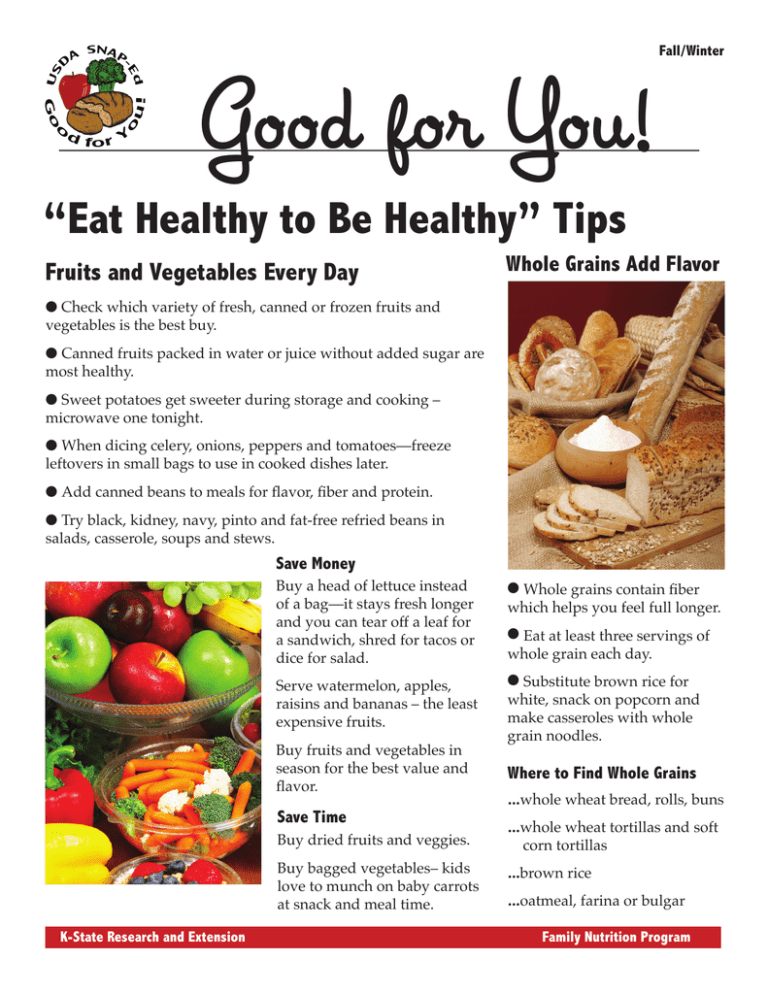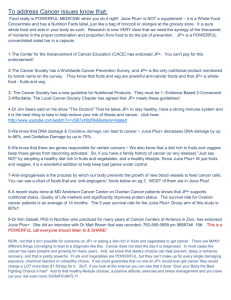Good for You! “Eat Healthy to Be Healthy” Tips
advertisement

Fall/Winter Good for You! “Eat Healthy to Be Healthy” Tips Fruits and Vegetables Every Day Whole Grains Add Flavor l Check which variety of fresh, canned or frozen fruits and vegetables is the best buy. l Canned fruits packed in water or juice without added sugar are most healthy. l Sweet potatoes get sweeter during storage and cooking – microwave one tonight. l When dicing celery, onions, peppers and tomatoes—freeze leftovers in small bags to use in cooked dishes later. l Add canned beans to meals for flavor, fiber and protein. l Try black, kidney, navy, pinto and fat-free refried beans in salads, casserole, soups and stews. Save Money Buy a head of lettuce instead of a bag—it stays fresh longer and you can tear off a leaf for a sandwich, shred for tacos or dice for salad. l Whole grains contain fiber which helps you feel full longer. Serve watermelon, apples, raisins and bananas – the least expensive fruits. l Substitute brown rice for white, snack on popcorn and make casseroles with whole grain noodles. Buy fruits and vegetables in season for the best value and flavor. Save Time Buy dried fruits and veggies. Buy bagged vegetables– kids love to munch on baby carrots at snack and meal time. K-State Research and Extension l Eat at least three servings of whole grain each day. Where to Find Whole Grains ...whole wheat bread, rolls, buns ...whole wheat tortillas and soft corn tortillas ...brown rice ...oatmeal, farina or bulgar Family Nutrition Program Lowfat Milk Has Vitamin D Good Sources of Lean Protein Eggs, beans, fish and peanut butter are good choices. Canned beans are easy to use and packed with protein. Rinse canned beans with water to reduce the salt. Canned tuna, salmon and sardines are low cost and contain healthy fats. l Dairy foods like milk and cheese provide your family with calcium and Vitamin D for strong bones and teeth. Sweetened Beverages and Juice Add Extra Calories l Lower fat milk has all the same nutrients as whole milk, just less fat and calories! l Sweetened beverages contain extra calories, sugar and often replace healthier choices. l Children 2-8 years of age need 2 cups of lowfat milk every day. Kids age 8 and above and adults need 3 cups. l Refrigerate milk at all times— germs can grow at room temperature. l Approved juices must be 100% juice – no juice drinks or juice cocktails because these contain sugar. l When you’re thirsty, go easy on juice since calories add up. Drink more water! Dried beans, peas and lentils are inexpensive and great sources of fiber. Make dry beans, peas, lentils and tofu the “center of your plate” several times a week. l Whole fruits make great snacks and desserts. l Buy canned fruit packed in its own juice. l Juices have little or no fiber— eat whole fruits and vegetables. A small handful of nuts adds flavor and nutrition to a snack. This material is funded by USDA SNAP. USDA is an equal opportunity employer and provider. SNAP provides food assistance to people with low income. It can help you buy nutritious foods for a better diet. For information, call 1-888-369-4777. For more information, contact your local Extension Office


